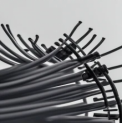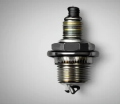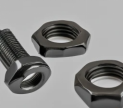Black Oxide: The Complete Guide
 Jul 28,2023
Jul 28,2023

You must be wondering what is black oxide? It is basically a black oxides coat used to provide a good surface finish to machined components. Now the question arises, what is the black oxide formula and how to coat a material with this? In this article, you will get all your answers about the black oxide coating. Following piece of writing will highlight its procedure, classifications, uses along with its pros and cons. After reading this article, all your curiosity and doubts about the black oxide coating will be wiped out and you will have all the essential information about black oxide required for your project.
What is black oxide?
Black oxide is a method which is related to conversion coating. These types of coatings involve chemical reactions to coat the components. ‘Black oxide’ name is due to the color of this process on any material which is matte or black and gives a black metal material. It is mostly carried out on machined parts because precision machined is essential in polished parts. And this improves the lifetime and appearance of machining components. Nevertheless, an issue that occurs in finished parts is the change in dimension of final product. This can affect the operation and working of accurate dimensioned parts. The black coating on steel gives an advantage regarding this issue. Because it provides a better satin finish, and the polished part has minimum dimensions change. The black coating steps are cleaning, rinsing, descaling of rust parts, black oxide finish and after finish step.
Black oxide finish
Black metal material is coated by a process in which steel is soaked in alkaline solutions by which iron is converted into magnetite. This compound provides black coating color on polished part. Metals that can undergo the black coating process are copper, zinc, steels, and silver etc. there are 3 various temperatures in this process. The hot temperature and mild temperatures are 141°C and 90 – 120°C. This finally gives a magnetite layer on metal. If the temperature is lower, the cold temperature black coating, this leaves copper selenium coat (Cu2Se) deposit on the satin finish. After this, the finish step is carried out and metal is coated with oils, waxes, and lacquer. Without this step, the black metal material is highly susceptible to corrosion. Therefore, this step is essential for anti-corrosion properties.
What does black oxide coating do?
Purpose of black oxide coating to provide corrosion resistance properties to polished or satin finish machined parts. The blackened parts are aesthetically pleasant and have minimum light reflection. The after-finish step provided with oil gives a glossy surface and improves lubrication and corrosion features. Wax provides matte look with higher corrosion resistance features. Lacquer gives satin finish of blackened parts and dries readily after coating.
Does black oxide rust?
No, it does not rust. The blackened parts have inherited anti-corrosion features and cannot be oxidized. After-finish step carried out with oils, waxes and lacquer provides corrosion resistance features with an appealing look. Black coating on steel is less susceptible to corrosion.
Black Oxide Classification
The black oxide coating is classified on the basis of operating temperature. These temperatures are different for different black coating processes. All temperature provides various satin finish on materials.
Hot black oxide
This is the famous category of black coating. In this process, material is soaked in oxidized salts at higher temperature up to 141°C. These solutions are nitrites and alkaline based salt bath. An auto-transporter shifts the materials into these solutions. The temperature must be maintained at this range because low temperature can lengthen the procedure and high temperature can get the part oxidized. The oxidized salts mixture can form magnetite over the material’s surface. Another method that is only carried out for black coating on steel products, is soaking the part in chloride baths. This procedure repeatedly soaked part in oxidized salts and then in hot water bath.
Mid temperature black oxide
The steps of the process are the same as the high temperature process only with the difference in temperature range. This range is 90 – 120°C. The conversion of magnetite also occurs in this process. But the main benefit of this process is that this finish does not generate caustic fumes.
Cold black oxide
This process is carried out at room temperature, and it is different than the other two processes. Copper selenide is the black oxide formula that is coated over the material which provides black coating on the material. This satin finish does not have high wea resistance, but the after-finish process can improve its properties.
Characteristics of Oxidized Material
Blackened steel
Blackened steels are gone through smelting method and carbon is added in steel. The final product has a satin finish and has higher hardness than the base metal. It is also very brittle. blackened steel has matte finished and cannot be corroded easily. Wear and tear resistance and durability are comparable that makes it good for structural applications. However, machining is difficult for blackened steel due to high hardness.
Blackened copper
Blackened copper is copper with iron oxide and nonferrous elements that are comprised of sulfides and oxides. When copper is present more than 80% in composition, it converts into anode or blister Cu. Blackened copper has corrosion resistance and hardness.
Titanium
Titanium is blackened by the heating process or adding alloying agent like ferrous oxides. There is no coating over the blackened titanium. Black titanium has many advanced features as compared to regular titanium. It is aesthetically pleasant and has high corrosion resistance. It is comparatively rare material as compared to others.
Iron
Black iron is used for coating ceramic materials. It is chemically known as magnetite. It has high corrosion resistance properties and has a pleasant appearance. It is mostly used as structural material in bridges and tower. They are nontoxic and also suitable for cosmetic applications. But for these purposes, they are produced synthetically. This helps in avoiding impurity and inclusions in the oxide.
Blackening stainless steel
Blackened stainless steel is produced by dipping in oxidized salts at certain temperatures. These products have good dimensional accuracy. The advanced corrosion resistance features and aesthetic pleasantness make them suitable for many applications.
Black oxide coating Application
Black oxide coating products have dimensional accuracy machined components; therefore, this finish has many applications. Corrosion resistance, good reflective properties and cost effectiveness further add the benefits of using this finish at large scale.
|
Applications |
Description |
Images |
|
Medical field |
Extremely suitable for medical equipment that is light sensitive like x-rays. Because black coating on steel has high light-absorbing properties. |
|
|
Electrical components |
Timer gears, wire stripper and cutter with black oxide finish provides good electrical properties. |
|
|
Auto component |
Black oxide finish parts like suspension bushing, spark plug, brake valve parts and oil filter can provide good corrosion resistance properties and long lifespan. |
|
|
Military applications |
Black oxide coating materials have used as military equipment like shotgun magazine or military humvees turret. Mid temperature black coatings are mostly utilized for this purpose. |
|
|
Assembly Tools |
High dimensional accuracy of machining components like bearing, fastener, and gauge are common example of black coating assembly tools. |
|
Black oxide vs titanium drill bits
The main difference between these is black oxide bits are for wood, and plastics while titanium drill bits for metals and alloys. The reason is titanium ones has high toughness than the black oxide coating. Therefore, woodworkers prefer titanium drill bits. They are high in hardness, robustness and are suitable for large scale industrial works.
Black oxide bolts
These bolts have many advantages. The dimensional accuracy is precise and have no corner thickness or piled up around the corners. Anti-corrosion properties are best with high abrasive resistance. durability is high, that’s why they are long lasting with decorative polished look. A satin finish makes it look good with material.
Black stainless fasteners
Stainless steel is used to make fasteners with black oxide coating. Chemical treatment is provided to change some features, especially the color. This treatment adds some extra features like corrosion and abrasion resistance and has good reflective properties. Wax or oil coating provides corrosion resistance features.
Deep black conversion coating on steel components
Deep black conversion coating is a general word referring to the coating process in which a chemical treatment is provided to metals and alloys. This electrochemical treatment produces layers on the surface of metal containing various compounds. The oxidized salts are bonded with metals which is black iron oxide magnetite (Fe3O4). Iron oxide forms a layer over the surface which only creates a bond and does not react chemically. The dimension accuracies do not become disturbed after this process. It is also carried out on other metals like steels, copper, and titanium.
Advantages of black oxide
Various benefits of black oxide can be availed. Some of them are:
- The polished treatment is cost effective for any machined components as compared to electroplating process which is relatively costly and required further steps to complete.
- The dimensional accuracy is better than any other coating process and just a few mm is changed in material after the procedure. This makes it perfect for precision application.
- The finishing procedure creates products with versatile features which is good for many industrial applications.
- Lubrication provided by after-finish step helps in making assembling parts and their joining is easy.
- Black oxide coating is aesthetically appealing, and it gives a part better look than any other electroplating method.
Black Oxide Disadvantages
This process also some disadvantages which are as:
- Continuously using black oxide coated components in warm conditions can result in wear off the finish and corrosion can occur.
- This finishing process is weaker as compared to other coatings and has low hardness and toughness.
Black oxide coated parts suitable for your own project
Surface treatment carried out for machined components are an important step to increase their quality. The black oxide coating is a relatively cost-effective method and is common for machined parts. This provides an excellent finish to the parts and provides a long life to the component. Dimensional accuracy adds an extra feature which shortens the coating procedure and is suitable for many applications. Other than this, it is appealing in looks as compared to electroplated materials. Therefore, the machined parts are essential to have coating like black oxides.
Conclusion
Black oxide is a coating method which is related to conversion coating type. This type of coating involves chemical reaction to carry out the coating process. ‘Black oxide’ name is due to the color of this process on any material which is matte or black and gives a black metal material. It is mostly carried out on machined parts because precision machined is essential in polished parts. And this improves the lifetime and appearance of machining components. Purpose of black oxide coating to provide corrosion resistance properties to polished or satin finish machined parts. The blackened parts are aesthetically pleasant and have minimum light reflection.
If you are looking for a reliable expert for coating, please visit: https://www.tuofa-cncmachining.com/
At Tuofa, different surface finishing processes are offered such as electroplating, anodizing, polishing, sand blasting and many more. Other than we are expert in providing services for precision machining process for your delicate parts. We are also expert indifferent prototyping services includes CNC machining, 3D printing and many more.
FAQs
Black oxide formula
The standard black oxide formula is magnetite which is relatively best bonded with machined parts surface in the presence of oxidized salts and improves corrosion resistance properties.
Black oxide coating kit
Oxidized salt, which is caustic soda, is the main black oxide coating kit which is carried out at different high temperatures. This causes the magnetite to create a bond over the surface of part of black oxide and provides corrosion protection.
How to black oxide steel
The black oxide steel is surface finished by soaking in the oxidized salts. The machined parts are normally black oxide coated. The solution deposits the iron over the surface of part and this iron as magnetite creates a black coating on the steel.
 Tel/WeChat:
Tel/WeChat:  Email:
Email: 
 Home
Home





 Surface Finish Chart: The Complete Guide
Surface Finish Chart: The Complete Guide 







